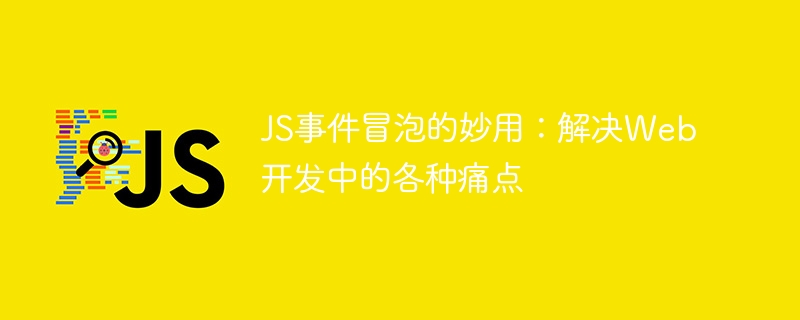

With the rapid development of Web development, JavaScript, as a powerful scripting language, has become an indispensable part of Web development. In JavaScript, event bubbling is a very important and useful feature, which can help us solve various pain points in web development.
Event bubbling means that in the DOM structure, when an element triggers an event, the event will bubble up from the element until it is passed to the top-level document object. In this process, we can use event bubbling to achieve some very practical functions.
First of all, event bubbling can implement event delegation. In web development, we often need to perform the same operation on multiple child elements under a parent element, such as binding a click event to each option in a list. If we use the traditional method, we need to bind events to each child element separately, which will undoubtedly increase the complexity and redundancy of the code. However, by using event bubbling, we only need to bind the event once to the parent element, and then use event bubbling to pass it to the parent element, and then determine the specific operation object based on the event source, which greatly simplifies the code. This method not only reduces the amount of code, but also improves the performance of the page.
Secondly, event bubbling can solve the problem of dynamic addition of elements. In web development, we often need to dynamically add new elements to the page, and these new elements may need to be bound to some events. If we use the traditional method, we need to bind the event after each new element is added, which undoubtedly increases the time cost of development and the difficulty of maintenance. With event bubbling, we only need to bind events to the parent element. No matter when and where a new element is added, it will automatically inherit the event of the parent element. This approach makes the code more flexible and scalable.
Thirdly, event bubbling can trigger multiple events at the same time. In some cases, we want to perform multiple events at the same time. For example, when the user clicks a button, we need to send a request to the server and change the color of the button to red. If we use the traditional method, we need to bind event handlers to each event separately, which will make the code verbose and difficult to maintain. Using event bubbling, we can perform multiple operations simultaneously in an event handling function, improving the readability and efficiency of the code.
Finally, event bubbling can achieve priority control of events. In some cases, we want certain events to have higher priority. For example, when the user clicks a button, if both element A and element B have click event bindings, we want to execute the event processing of element A first. function. By utilizing event bubbling, we can call the event.stopPropagation() method in the event handling function of element A to prevent the event from bubbling, thereby controlling the priority of the event.
To sum up, event bubbling is a very important and useful feature in web development. It can help us solve various pain points. By event delegation, solving the problem of dynamically adding elements, triggering multiple events at the same time, and controlling the priority of events, we can write more concise, efficient and maintainable code. Therefore, in web development, we should give full play to the advantages of event bubbling and make reasonable use of it to improve our development efficiency and user experience.
The above is the detailed content of Use JS event bubbling to solve problems in web development. For more information, please follow other related articles on the PHP Chinese website!
 What problems can js event bubbling solve?
What problems can js event bubbling solve?
 How to enable JavaScript
How to enable JavaScript
 Ripple currency market trend
Ripple currency market trend
 Is wifi signal amplifier useful?
Is wifi signal amplifier useful?
 Digital camera driver
Digital camera driver
 What are the java flow control statements?
What are the java flow control statements?
 What is the difference between css framework and component library
What is the difference between css framework and component library
 How to cancel automatic renewal at Station B
How to cancel automatic renewal at Station B




